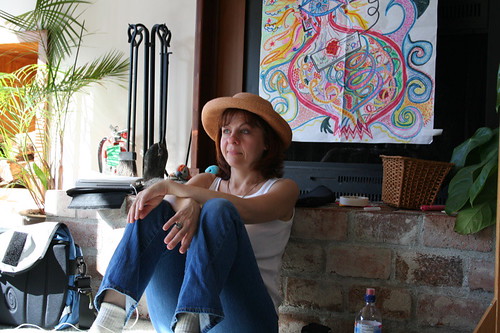Learning, Capturing and Sharing Conference Artifacts
Beth has a great synthesis post on Collaborative Models for Capturing and Sharing Conference Notes at Nonprofit Gatherings: "I wonder what collaborative thinking through our fingers might look like when it comes to capturing and sharing notes from conferences, dialogs, meetings or informal gatherings. I often see many people taking notes at conference, either with pen in a moleskin or typing into a laptop. How can those notes best be aggregated in one place to be shared with all participants and perhaps with those who didn't attend the event?"
Beth goes on to talk about event blogs, wikis, shared photo streams, and shared tags as tools to help a group both capture and make meaning of what is going on at a F2F event, and sharing it out to the wider world. For me, this is not just a practice and tech issue, but a fundamental issue on how we learn together and share our learnings. More on that at the end. First, let me bounce off of Beth's good thinking.
I'd probably add a few more to it both from the "sending out" perspective and to the weaving in of the voices of people NOT at the F2F event.
Chat Rooms and IRC Channels
For groups that are used to being online at F2F gatherings, having a chat room or IRC (Internet Relay Chat) channel open so that both in room participants and those not present have a way to interact, pass resource information and weave the onsite and distributed group together. I have found IRC to be a bit geeky for second wave adopters, so using a web based chat appliation may be a useful alternative. Some examples of this that I've appreciated have been the IRC back channel this year at the Microsoft Social Computing Symposium. The event limited physical space, but organizer Liz Lawley allowed the rest of us full access, not just with IRC, but with real time video streaming of the sessions. Oh, I should add that as a category.
VideoCasts
Real time streaming of session video, or captured for later, time shifted distribution. This adds cost, but with today's amazing video cameras, even an dabbler can help make this happen. A key is a good microphone for the speaker. Don't skimp there. Don't trust the audio pickup from the camera at the back of the room.
VOIPCasts
With the availability of free and low cost voice over IP (VOIP) conference calling, you can open a line from "the room to the world." An example of that is Skypecasts. Key practices here include the use of the MUTE button by the listeners until they are ready to speak. Otherwise you have a messy sound soup. Or glop! These can also be recorded and sent out as podcasts. The informal learning gang has been using them this year.
Podcasts
Speaking of podcasts, recordings are great artifacts. Earlier this year, Alan Levine recorded a talk of mine, others took notes from afar, I added jpgs of my slides and we collaboratively created a post conference artifact that appears to have been really useful to others.
Graphic Facilitation/Graphic Listening
Finally, I have been exploring the value of visual facilitation at F2F events and have been finding that sharing digital scans or pictures of these meeting artifacts, especially images which capture not only information, but emotion and the "warm human parts" of the communications and interactions can enrich the remote experience of F2F information capture. I used to see this as "facilitation" when I did it, but I am learning from the master, Nancy Margulies, that this is really about listening. From a very personal perspective, when I'm doing this drawing, it REALLY deepens my own listening. When I can successfully invite others into co-creation of the drawing, it creates new meaning for the group.
It is about the Learning!
In the end, the key around these practices is that when we engage all or part of the group in the production of our "learning artifacts" -- we all learn more AND we make some of that learning available to others. The act of production is an act of meaning making.
We also think beyond our individual selves. We resume responsibility not only for our participation, but for sharing back to the communities we come in to the room representing. F2F is a precious resource, not to be squandered. It is a privilege.
That's the bottom line.

0 Comments:
Post a Comment
Links to this post:
Create a Link
<< Home